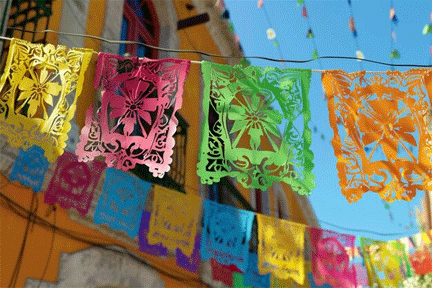Mexican Tradition: Papel Picado “shredded paper”
News Category: News and General Discussion
-
Published October 6, 2024
Do you know the history and meaning of Papel Picado “shredded paper” in Mexican traditions? In addition to providing color to the offerings, it is important as an element.
“Papel Picado” this is its history and meaning.
The Day of the Dead is represented with different elements, such as food for the dead, flowers, candles, etc. But, without a doubt, one of the most important is the papel picado, so colorful, volatile and fun that it fascinates us.
Furthermore, there are those who claim that if an offering does not have papel picado (shredded paper), the color and the wind are not represented correctly on each altar.
Papel picado is made from a paper that is not Mexican and has its origin in a social sector that is somewhat unprotected thanks to colonization and imports from other countries. From being part of the union between Mexico and Europe it became a prevailing part of the Day of the Dead.
Flowers in general are beneficial in the offering, but they are not the only ones that accompany our dead.
Where was papel picado born?
The beautiful and colorful papel picado was born in the 19th century, when China imported colored paper such as white or black—hence the name “China paper”—but it was taken to Europe and from there it reached our territory. However, it did not sell much since it had no real or useful use since it is light and although resistant, its end was near.
Thus, the stripe stores located in the large estates ( haciendas ) sold it, but not to make papel picado, but to use at home. Since they were not sold, the laborers were forced to acquire sheets of paper to put them to use. Legend has it that in some of the stores they sold shredded paper and explained that this is how it was used in China, on the other side of the world and it is real.
In China, paper is used to create art, but this technique stood out in which figures are cut out of pieces of paper, which was transferred here and is called papel picado to this day. Puebla was the place where China paper arrived the most and therefore, it was the inhabitants who acquired it the most, more specifically, Huixcolotla.
Thus, the laborers, in addition to dedicating themselves to agricultural work, learned to cut paper and when they saw that they were beautiful and could be produced in large quantities, they decided to sell them in nearby towns.
By the first years of the 20th century, chopped paper was already sold in Puebla and Tlaxcala to reach Mexico City, so it began to be put in offerings as a symbol of the wind, because it lets us remember that the altars are made up of the four items. Likewise, it was used to decorate the holidays on September 15 and social or religious festivals. Thanks to this, papel picado is part of the cultural heritage of the state of Puebla. Today, confetti is made with scissors, knives and chisels, some have letters, figures alluding to the right and even characters like
Hello Kitty or The Simpsons.
The meaning of the shredded paper in the offering,
as we mentioned before, shredded paper is part of the four elements. This alludes to fire, while the fire is found in the candles, the earth in the fruits and in the sawdust and finally the water that is placed in clay trays or small jugs, preferably.Paper itself is a kind of communicative channel between life and death, since in ancient Mesoamerica amate paper was used to write codices and was considered a material from the gods. This is because the amate was a tree related to the underworld, since it was said that through it you could get from the world of the living to the world of the dead, so the shredded paper fulfills that function in the offering.
Meaning of the colors of the papel picado
In addition to representing the wind on the altar, the papel picado has a special meaning depending on the color it has:
White: The purity of deceased children.
Black: The underworld.
Orange: Mourning and respect for the dead (it is believed that it is the only color that the deceased can identify and that the rest of the colors do not exist, everything is gray).
Purple: It is a representation of the Catholic Church, although it can be worn even if one does not profess that religion.
Blue: Deaths caused by water.
Red: Women who died during childbirth and men who died in war.
Green: Young dead.
Yellow: Elderly or elderly deceased.
Pink: Our country.By Diana Garrido Architectural Digest Mexico.
Translated by Efrain Gonzalez San Miguel de Allende.


Leave a Reply